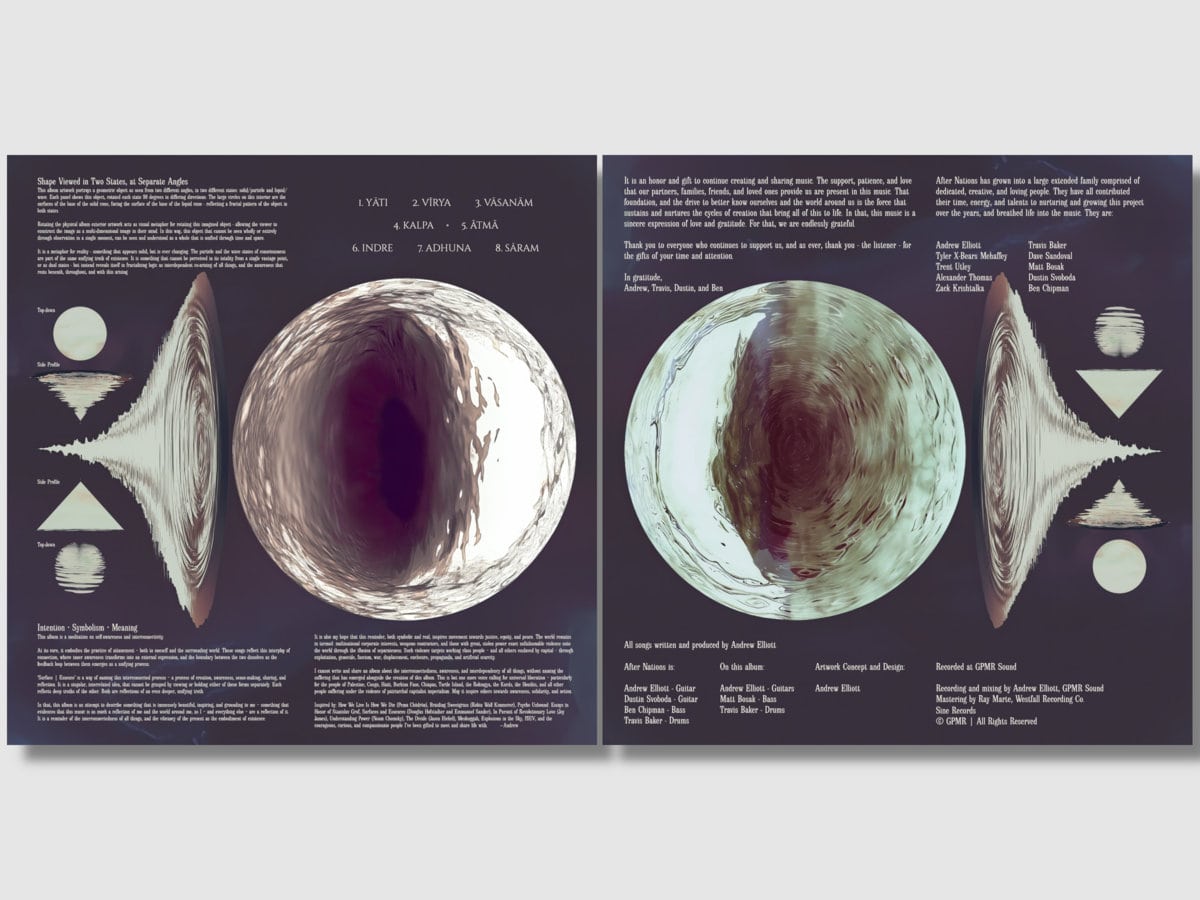A new full-length from After Nations arrives today, merging crushing post-metal riffs with the spacious reach of post-rock. The band describes it as “the sound of Meshuggah colliding with Explosions in the Sky,” a tidal force of brutality and contemplative calm.
“Surface | Essence,” is built around secular Buddhist concepts of self-awareness and interconnectivity. Musically, it traverses the breadth of heavy sludge, calculated djent, and introspective post-rock, shaped by cyclical motif-building that never loses sight of raw power. It stands as a heavy, dynamic, and hypnotic statement.
From the slow, rolling movements that seep through our ears and mind, through the tranquil interludes that briefly lull us, to the formidable, progressively complex, near-mathematical strikes of the instruments, this wordless approach to music creates a truly grand adventure.
The quartet’s multi-year path of DIY recordings and tours across the United States fostered a dedicated underground following, pushing them to refine a sound that intersects djent, stoner metal, and heavy post-rock.
The group’s current lineup features Andrew Elliott (guitar), Travis Baker (drums), Dustin Svoboda (guitar), and Ben Chipman (bass). “I think of everyone that has shared in this experience with me as an extended family,” says Elliott. “Everyone has contributed their time, energy, and talents in unique ways, helped nurture and grow this project over the years, and breathed life into the music.”
“The sound of the project has shifted and evolved over time, reflecting changes in my own interests and musical tastes. Prior to the pandemic, events in my own life led me towards exploring secular Buddhism, and that’s looked like a daily practice of meditation, yoga, or some form of reflection to cultivate greater intention and awareness. At the peak of the pandemic, that dimension expanded considerably as I immersed myself in community organizing, equity advocacy, and founding and maintaining a mutual aid project, interspersed with periods away from those activities to restore some life balance.”
Elliott points to those experiences as central to how the new album was composed. His writing process focuses on accent patterns, minimal ideas that expand in multiple permutations.
“On this new album, songs are typically centered on a single musical idea – like a very essentialized and stripped down accent pattern, for example. I would sit with a particular idea – elaborating, experimenting, iterating, creating permutations to explore its possibilities, seeing what comes up, what arises.”
“Songwriting in that way can feel like a form of meditation; a focusing of intention, discovering what is there, what’s present in a musical idea, a thought. That can even begin to feel like a blurring of what is arising from ‘me,’ and everything else around me from which my thoughts are interdependent, and interconnected. Songwriting can feel like the broader universe revealing aspects of itself, just as much as it feels like observing my own thoughts, and practicing a creative process. I may have an idea or an impulse, but I never know what it is I’ll discover, uncover, or find.”
“That whole experience feels like channeling something greater than the idea of a singular self, and it feels connecting, curious, wondrous, exciting – not wholly known, and emergent. It’s what grounds and excites me in writing and creating music.”
This meditative undercurrent runs parallel to a mission of resilience within a precarious industry climate.
“This kind of secular Buddhist orientation also informs how I come to live music. The music industry has created an enormous amount of obstacles that threaten the sustainability of creating and sharing music – resulting in musicians working under a degree of exploitation that is virtually absolute. We create music that has been devalued to the tune of 1/3rd of a cent per stream, touring guarantees that haven’t changed since the 90s, and an expectation to create and share art in exchange for ‘exposure’ or less. And in all of that, we’re often given the message within the industry to be grateful for this landscape of total exploitation.”
“So the industry has devalued the labor of musicians beyond absurdity, and this actively harms the ability of artists to continue to create and make a sustainable living. That directly threatens and exploits the vast majority of artists, and that’s the industry’s neo-liberal, capitalist position. It is fundamentally anti-music, and anti-community.”
“In response, I try to book tours that engage with independently owned and operated venues, to avoid predatory bookers and promoters, and to work with bands that on some level value engaging as a community.”
“I think these choices contribute to shows that foster spaces where we get to share, express, and bear our creative, vulnerable selves, our truths, our dreams and hopes with one another – to better know and love who we all really are – at our most sacred and aspirational, and to grow with that shared space of dreaming, more richly and fully together.”
“Surface | Essence” itself serves as both a reflection and a practice of bridging personal awareness with all external forces:
“This album is a meditation on self-awareness and interconnectivity.” – says Elliott. “At its core, it embodies the practice of attunement – both to oneself and the surrounding world. These songs reflect this interplay of connection, where inner awareness transforms into an external expression, and the boundary between the two dissolves as the feedback loop between them emerges as a unifying process.”
“‘Surface | Essence’ is a way of naming this interconnected process – a process of creation, awareness, sense-making, sharing, and reflection. It is a singular, interrelated idea, that cannot be grasped by viewing or holding either of these forms separately. Each reflects deep truths of the other. Both are reflections of an even deeper, unifying truth.”
“In that, this album is an attempt to express and describe something that is immensely beautiful, inspiring, and grounding to me – something that evidences that this music is as much a reflection of me and the world around me, as I – and everything else – are a reflection of it. It is a reminder of the interconnectedness of all things, and the vibrancy of the present as the embodiment of existence.”
The same interplay shapes the album’s visuals.
Elliott created a geometric concept that shows a duality of forms:
“The album artwork portrays a geometric object as seen from two different angles, in two different states: solid/particle and liquid/wave. Each panel shows this object, rotated 90 degrees in differing directions. The large circles on this interior are the surfaces of the base of the solid cone, facing the surface of the base of the liquid cone – reflecting a fractal pattern of the object in both states.”
“Rotating the physical album artwork acts as a visual metaphor for rotating this imagined object – allowing the viewer to construct the image as a multi-dimensional image in their mind. In this way, this object that cannot be seen wholly or entirely purely by observation in any given moment, can be seen and understood as a whole that is unified through time and space.”
“It is a metaphor for reality – something that appears solid, but is ever changing. The particle and the wave states of consciousness are part of the same unifying truth of existence. It is something that cannot be perceived in its totality from a single vantage point, or as dual states – but instead reveals itself in fractalizing logic as interdependent co-arising of all things, and the awareness that rests beneath, throughout, and with this arising.”
After Nations invites you to explore the entire track-by-track commentary below, published in full:
The album consists of eight songs and eight interstitials. The album’s track listing is circular, with the final interstitial [~Arha~] being the intro to the opening track [Yāti].
Here’s the full track by track rundown.
1. Yāti
Named after the Pali word for “to proceed” or “to strive”, Yāti reflects the undertaking of a journey of self-mastery and perseverance. It is the path of the mendicant, the hermit, and the forest-dwelling monk – practices of opening and surrendering self to society, ourselves, and the natural world around us in search of deeper understanding.
~Pātra~ Bowl
2. Vīrya
Vīrya refers to the Buddhist concept of the virtue of energy, applied to realizing the wellbeing of all beings. It conveys an unyielding drive that channels the strength needed to achieve a state of focused, expansive awareness.
~Spanda~ Pulse
3. Vāsanām
Vāsanām is a Sanskrit word referring to the concept of latent knowledge – the impressions left on the mind by past experiences. It evokes the idea that all knowledge exists within us, filtered through human consciousness, which both empowers and limits our perception of the universe. It is the recognition that our human experience of reality is just one medium through which awareness arises – and that it, like other forms of consciousness, are vehicles of the infinite depths of the universe to express, understand, and know itself.
~Shringa~ Horn
4. Kalpa
Named after the Sanskrit term for an immense cycle of time, Kalpa reflects concepts of creation, destruction, and rebirth. It conveys the temporal scale of universal cycles, and the impermanence that applies even to such vastness.
~Nāda~ Voice
5. Ātmā
Ātmā is a Sanskrit term referring to “self”, or awareness through one’s mind, body, and senses. Inspired by the Katha Upanishad, it explores the nature of self as distinct yet interconnected with all existence – the non-duality understanding of a sense of individuality arising from and with the unity of all things.
~Yātrā~ Procession
6. Indre
Referencing the “Indriyas,” or mental qualities in Buddhism, Indre is a meditative piece that centers on cultivating faith, concentration, and wisdom. The track is both contemplative and powerful, capturing the depth and focus needed to perceive the nature of reality clearly and lovingly.
~Kha~ Firmament
7. Adhuna
The term “Adhuna” translates from Sanskrit to “now” or “present moment.” It conveys the importance of the present moment as the locus of existence unfolding – that life, and our connection to it – is always occurring as immediacy.
~Laraja~ Vibration
8. Sāram
Sāram, meaning “essence” or “core” in Sanskrit, encapsulates the album’s core theme: that surface and essence are reflections of one another. That the interior or essence of something is fundamentally a reflection of its surface manifestations, and vice-versa. That these exist as fractal patterns of one another, reflecting truths and realities of the interrelationship of all things.
~Arha~ Worthy

















